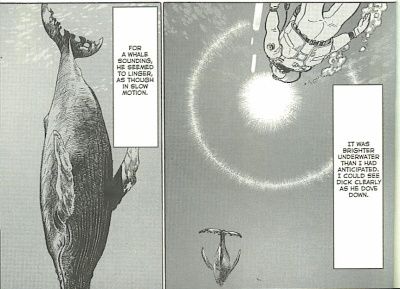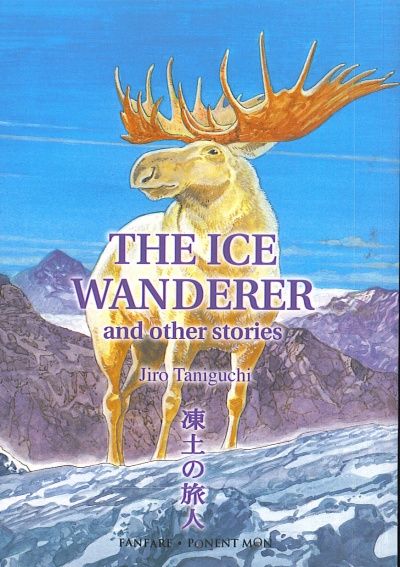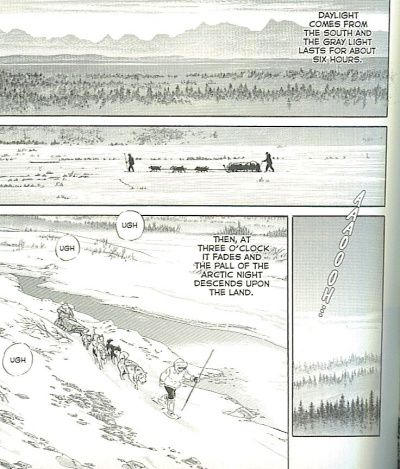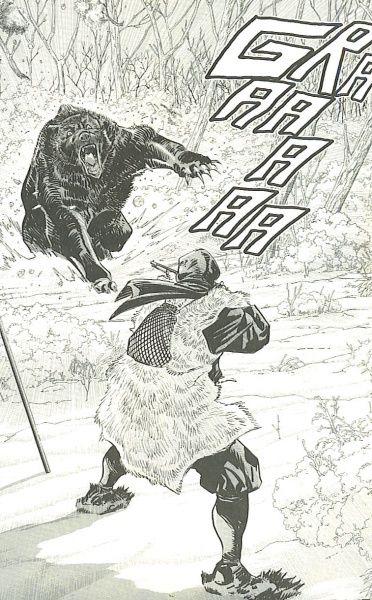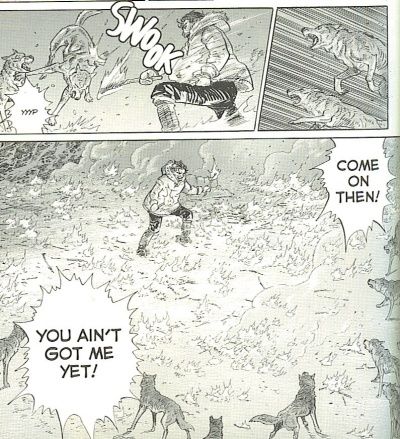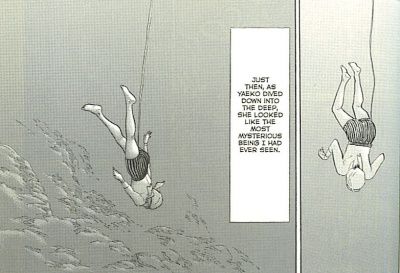The title of this post, by the way, does not imply that I didn't like this book. I mean that it's not what seems to be "regular" manga, soI probably still haven't experienced the true style.The comic I did read doesn't feature girls with eyes taking up most of their face, talking animals (it does feature animals, however!), boys who shoutall the timeandfight giants robots,or lots of motion lines becauseno one can sit still. But it's by a well-respectedJapanese artist!
Themanga is The Ice Wanderer and other stories by Jiro Taniguchi. It's published by Ponent Mon and costs $21.99. It collectsstories published from 1994-2004, at leastone of them adapted from a Jack London story (all of them might be, actually - I haven't read very muchJack London, so I'm unfamiliar with the source material). Six stories make up the collection, and it's well worth your money - if you can deal with the fact that the spine on the book is one the wrong side! What's up with that????
Taniguchi gives us tales of the wilderness and man's place in it.He starts with exciting, man vs. nature kind of stories, and gradually, they become more reflective of how menlearn about their place in nature and how to respect it. That's a broad look at the stories, as the early ones in Alaska show men respecting nature even as they battle the elements, while the later stories are still very exciting even as they become more pensive. There's a short story about a cartoonist living in an apartment building that seems out of place, but it fits in with the theme of people trying to figure out their environment and how to live in it.
Each story features a protagonist who has to learn something about himself (they're all male)and his place in the world. This ties the stories together, from thefirst one, "The Ice Wanderer,"which features Jack London himself as the protagonist, to the final one, "Return to the Sea," in which an unnamed marine biologist desperately tries to discover the mythical whale cemetery. In each, the protagonist must make a choice that will define his life forever. The choices are difficult, but they're meant to be. How else can the protagonists grow? So we get Jack London and his companions meeting an oldChilkoot tribesman who saves them from a winter storm and tells them he is looking forthe lord of the north, the white moose, to ask him to save his people.Jackand his friends are in the mountains panning for gold, but Jack must soon make a decision about what's really important in life and what is worth dying for. In the second story, two men take the body of a third back to civilization, but there are wolves circling themand harrying them throughout the story. This is the most thrilling andfrightening of the collection, because we're not entirely sure who will survive, if either of them will. They also have a choice to make, between abandoning their responsibilitiesand trying to save themselves or trying to survive but breaking a promise in the process. In the third story, a man huntsa bear that killed his son. In doing so, however, he may betray the rest of his family. In the fourth story, a boy must choose to take control of his life and not allow himself to be pushed around, but he soon learns that growing up means some things become far less safe. The fifth story tells of the cartoonist, who lives alone and cuts himself off from the rest of the apartment building's tenants, but he comes to realize that he can't live that way and he must reach out to someone. Finally, "Return to the Sea" is a portrait of a struggle between respecting the privacy of death and the communion we feel with all living things. The marine biologist appears to be someone who just wants to find the whale graveyard because he's selfish and wants the thrill of discovery, but he soon realizes it's something much deeper, a connection to the whale he has studied for years that goes beyond mere scientific inquiry. This makes him understand his place in the world much better.
The plots of the stories tie them together, but so to do the motifs Taniguchi uses throughout the book. Life and death, of course, are closely linked in the stories. The whale that heads off to the graveyard is going there to die, of course, but he teaches the marine biologist something about life as he does so. This death, coming at the end of the book, is countered with a birth, as a dying dog in one story gives birth to a single pup, which is traditionally seen as a blessing. Each character gets a chance to be reborn in different ways. Master Gunpachi, the protagonist of "Our Mountains," has sworn not to pick up a gun again after the bear killed his son. When the bear returns, however, he chooses to hunt it because it's in his nature. On the mountain, however, he is reborn: he kills the bear, but gains a new respect for life, a respect he had buried when his son died. The fourth story, "Kaiyose-Jima," features Takashi, a young city boy sent to a fishing village while his mother is hospitalized. In the village he meets Yae-Chan, a girl a few years older than he. Yae is wonderfully free-spirited, and she helps show Takashi how to stand up for himself and take some chances. But her attitude also leads to danger, and one day she and Takashi go too far out to sea. This is the dark side of living life to the fullest, and Taniguchi invites us to ask whether Takashi would have been better off not taking the chance. Of course, he doesn't believe it himself, but he allows for that possibility. The idea of death leading back into birth is there throughout the book, even in a story as incongruous as "Shôkarô," the story about the cartoonist. The story is named after the apartment building, which used to be a brothel. The unnamed artist is reborn when he leaves the building, which burns down at the end of the story. However, while he was there, he experienced death in both the abstract (a middle-aged woman is touched by his drawings because it reminds her of her brother, who died young) and in the concrete (he sees a ghost, which isn't all that concrete, but he does experience it directly). This informs his future and helps him become a better person.
Taniguchi's magnificent art helps turn these stories into more than mere adventure stories. His landscapes are gorgeous, especially in the stories set in Alaska. He places his characters in stark wilderness, dwarfing them with immense mountains and obliterating them with the starkness of the snow and the rocks. The idea of man existing as part of nature is most evident in the art, as the people in the stories become part of the world around them instead of rising above it and dominating it. These are people locked in a struggle with their surroundings, trying to find a balance within their worlds. He has a wonderful sense of design, both with the landscapes and the more dynamic scenes. More than anything, this is a thrilling book to read. When the wolves gather to attack the man taking the corpse back to civilization in "White Wilderness," Taniguchi gives us a wonderful fight scene, brutal, nasty, and confused, but he never lets the action overwhelm the storytelling. He paces the stories extremely well, building the tension throughout and letting us see the way the characters are part of the environment before focusing on them, so that we're always reminded of where they fit. The final story, "Return to the Sea," is a masterpiece of artistic rendering. His whale is spectacular, retaining what makes it an animal while bonding with the marine biologist on a level beyond his understanding. Taniguchi never allows us to forget that it's an animal, but he also shows us that the animals can communicate with us without speech. He does this very well throughout the book: the moose in the first story is a totemic figure, communicating with Zing Ha, the man who saved Jack London's life; the stalking wolf in "White Wilderness" is almost malevolently intelligent; the bear in "Our Mountains" a horrific force of nature. Taniguchi's beautiful drawings make them more than mere animals, but actors in the human drama going on in each story.
This is a wonderful book that gives us thoughtful insightabout the nature of man and his relationship with the world around him. It's exciting, thrilling, reflective, and hopeful. Taniguchi's stories and art create a world where people learn powerful truths about the universe and themselves. And for those of you who really, really like manga, well, one of the protagonists kind of looks like Tetsuo from Akira. Sorry, that's all I've got. You'll just have to buy the book and check it out! And maybe someday I'll read some "real" manga. It could happen!

